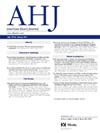远程临床护理(TCC) -心脏试验的基本原理和设计:心血管事件二级预防辅助虚拟护理模型的实用随机试验。
IF 3.7
2区 医学
Q1 CARDIAC & CARDIOVASCULAR SYSTEMS
引用次数: 0
摘要
背景:数字健康干预有可能通过远程监测和患者教育改善高危心脏病患者的预后,但会给缺乏合适智能手机的患者带来可及性问题。我们将评估远程临床护理心脏(TCC-Cardiac)平台的有效性和可扩展性,该平台旨在减少医院再入院率并提高护理依从性。方法:一项实用的、采用嵌套随机化的所有患者试验,其中入院后因急性心肌梗死(MI)或失代偿性心力衰竭(HF)出院的患者根据其获得技术的程度分为三个实用的队列。队列1的参与者被随机分配到TCC-Cardiac治疗模式或单独的常规治疗。干预包括智能手机应用程序、血压监测仪、体重秤和脉搏血氧仪,并由临床医生远程监测日常输入。队列2的参与者使用不兼容的手机,随机接受短信(TCC-Text)或常规护理的教育内容。第三组没有手机的参与者单独接受常规护理。主要目的是比较队列1的6个月再入院率(主要终点)。次要目标包括比较主要终点,评估所有队列和干预措施的成本效益和总体影响,以及了解全面干预措施的范围、采用和有效性的过程评估。随访包括对队列1进行为期6个月的访谈,并对所有队列进行为期12个月的数据链接。结果:试验于2021年7月开始。由于与COVID-19相关的延迟和中断,招募比预期的要慢,最终招募日期定于2023年10月,届时已招募了873名参与者:队列1 553名(63.3%),队列2 161名(18.4%),队列3 159名(18.2%)。数据链接预计将于2025年5月进行,其中包括6个月的延迟,以确保所有研究患者可获得12个月的数据,然后进行结果分析。结论:TCC-Cardiac是第一个评估高危心脏病患者住院后基于智能手机的短信和远程监测的大规模研究。该研究的实用设计和过程评估旨在加强未来的实施。本文章由计算机程序翻译,如有差异,请以英文原文为准。
Rationale and design of the TeleClinical Care Cardiac (TCC-Cardiac) trial: A pragmatic randomized trial of adjunctive virtual models of care in the secondary prevention of cardiovascular events
Background
Digital health interventions have potential to improve outcomes in high risk cardiac patients through remote monitoring and patient education but introduce accessibility issues among patients who lack suitable smartphones. We will evaluate the effectiveness and scalability of the TeleClinical Care Cardiac (TCC![]() Cardiac) platform, that aims to reduce hospital readmissions and improve adherence to care.
Cardiac) platform, that aims to reduce hospital readmissions and improve adherence to care.
Methods
A pragmatic, all-comers trial with nested randomization, where patients being discharged home following an admission with acute myocardial infarction (MI) or decompensated heart failure (HF) are divided into 3 cohorts pragmatically, based on their access to technology. Cohort 1 participants are randomized to either the TCC![]() Cardiac model of care or usual care alone. The intervention includes a smartphone app, blood pressure monitor, weight scales, and a pulse oximeter, with remote monitoring of daily inputs by clinicians. Cohort 2 participants, with incompatible mobile phones, are randomized to receive educational content by SMS (TCC-Text) or usual care alone. Cohort 3 participants with no mobile phone receive usual care alone. The primary objective is to compare six-month readmission rates (primary end point) in Cohort 1. Secondary objectives include comparing the primary end point, evaluating the cost-effectiveness and overall impact across all cohorts and interventions, and process evaluation to understand the reach, adoption, and effectiveness of the full intervention. Follow-up includes 6-month interview for Cohort 1 and data linkage for all cohorts for 12-month outcomes.
Cardiac model of care or usual care alone. The intervention includes a smartphone app, blood pressure monitor, weight scales, and a pulse oximeter, with remote monitoring of daily inputs by clinicians. Cohort 2 participants, with incompatible mobile phones, are randomized to receive educational content by SMS (TCC-Text) or usual care alone. Cohort 3 participants with no mobile phone receive usual care alone. The primary objective is to compare six-month readmission rates (primary end point) in Cohort 1. Secondary objectives include comparing the primary end point, evaluating the cost-effectiveness and overall impact across all cohorts and interventions, and process evaluation to understand the reach, adoption, and effectiveness of the full intervention. Follow-up includes 6-month interview for Cohort 1 and data linkage for all cohorts for 12-month outcomes.
Results
The trial began in July 2021. Recruitment was slower than expected due to delays and interruptions related to COVID-19 and the final enrolment date was set for October 2023, by which time 873 participants had been enrolled: 553 in Cohort 1 (63.3%), 161 in Cohort 2 (18.4%), and 159 in Cohort 3 (18.2%). Data linkage is anticipated in May 2025, which includes a 6-month delay to ensure 12-month data will be available for all study patients, followed by the analysis of results.
Conclusions
TCC![]() Cardiac is the first large-scale study to assess smartphone-based messaging and remote monitoring in high-risk cardiac patients post-hospitalization. The study's pragmatic design and process evaluation aim to enhance future implementation.
Cardiac is the first large-scale study to assess smartphone-based messaging and remote monitoring in high-risk cardiac patients post-hospitalization. The study's pragmatic design and process evaluation aim to enhance future implementation.
Trial Registration
Australian New Zealand Clinical Trials Registry Number ACTRN12621000754842.
求助全文
通过发布文献求助,成功后即可免费获取论文全文。
去求助
来源期刊

American heart journal
医学-心血管系统
CiteScore
8.20
自引率
2.10%
发文量
214
审稿时长
38 days
期刊介绍:
The American Heart Journal will consider for publication suitable articles on topics pertaining to the broad discipline of cardiovascular disease. Our goal is to provide the reader primary investigation, scholarly review, and opinion concerning the practice of cardiovascular medicine. We especially encourage submission of 3 types of reports that are not frequently seen in cardiovascular journals: negative clinical studies, reports on study designs, and studies involving the organization of medical care. The Journal does not accept individual case reports or original articles involving bench laboratory or animal research.
 求助内容:
求助内容: 应助结果提醒方式:
应助结果提醒方式:


